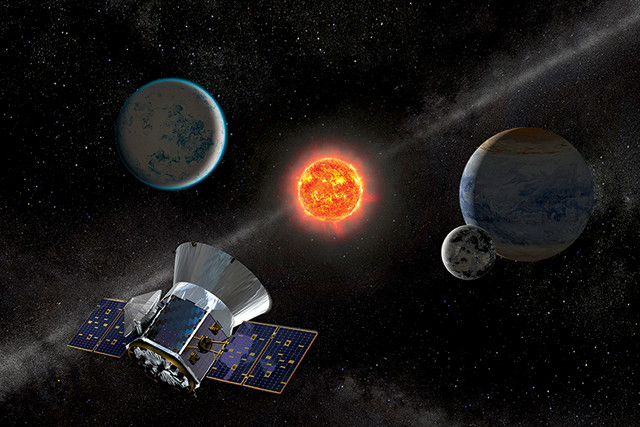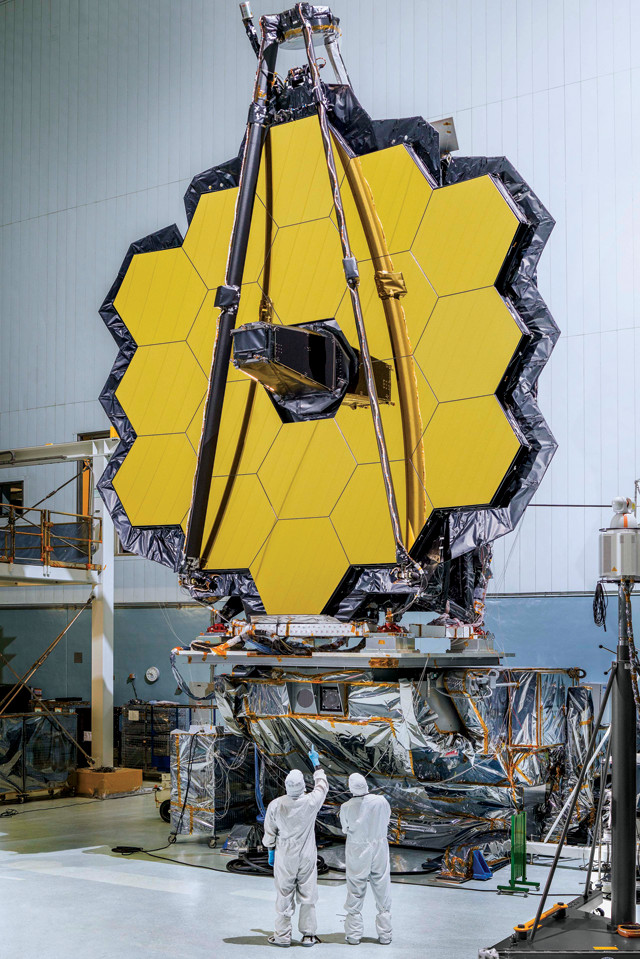
by Jacob Haqq-Misra Tuesday, May 1, 2018

The Transiting Exoplanet Survey Satellite, which launched in April, is the successor to the Kepler Space Telescope and is the most sophisticated exoplanet-hunting spacecraft yet. Credit: NASA Goddard Space Flight Center.
by Jacob Haqq-Misra
Exoplanet discoveries are featured almost weekly in the news. With ground-based observations supplementing the Kepler Space Telescope during its nine-year mission, more than 1,000 exoplanets have been discovered. We now know that rocky planets are commonplace in the galaxy, which suggests that more than a few should be situated the right distance from their host stars to sustain habitable conditions on the surface. Recent discoveries, such as the seven planets in orbit around the red dwarf star TRAPPIST-1, exemplify the diversity of worlds that we have only begun to uncover. But, so far, evidence of extraterrestrial life remains elusive.
Two upcoming missions may change that, focusing our search on nearby stars, including low-mass red dwarfs, as well as stars like our sun. The Transiting Exoplanet Survey Satellite (TESS), which launched in April, will use a similar method as Kepler, detecting the faint dimming that occurs when a planet passes in front of its host star. During its planned two-year mission, TESS will provide unprecedented capabilities to detect the exoplanets nearest to our solar system.
The other mission is the James Webb Space Telescope (JWST), the successor to the Hubble Space Telescope. After launch, JWST will perform a wide range of astronomical observations — including the characterization of exoplanet atmospheres. JWST, which has already been delayed many times, was scheduled to launch in 2018 and operate in tandem with TESS; however, recent technical setbacks have now delayed the launch until 2020. Nevertheless, exoplanet detections by TESS, and subsequent characterization with JWST, will provide the first systematic approach to searching a planetary atmosphere for signs of life.
One thing they will be looking for is the “smoking gun” signature of life espoused by many astrobiologists — the simultaneous presence of methane and oxygen in a planet’s atmosphere. Atmospheric oxygen originates mainly from photosynthesis and supports respiration on Earth, while biology is a significant source of methane. Methane and oxygen interact in the atmosphere, and would become depleted if they were not continually replenished by life. The discovery of a water-rich planet, orbiting within the habitable zone of a sun-like star, with methane and oxygen observable in its atmosphere, would represent the first actual candidate for an inhabited planet.
Planets resembling early Earth could also provide an alternative scenario for an inhabited planet, with no atmospheric oxygen and possibly a thick layer of organic haze, similar to conditions found on Titan. Likewise, studies of the past climate of Mars provide scenarios with dense carbon dioxide atmospheres that could sustain liquid water oceans and, perhaps, life. Astrobiologists remain cautious about over-interpreting any such scenarios and continually suggest alternative abiogenic mechanisms that could cause the same observable signal. Today, theoretical work by astrobiologists provides a basis for characterizing the “biosignatures” that missions like TESS and JWST will be looking for after launch.
Mission studies are currently underway to prepare for NASA’s next generation of space telescopes after TESS and JWST. Three contenders to advance exoplanet science are the Habitable Exoplanet Imaging Mission (HabEx), the Large Ultraviolet Optical Infrared Surveyor (LUVOIR) and the Origins Space Telescope (OST), all of which would enable precise characterization of exoplanet atmospheres far beyond the capabilities of JWST.

Technicians look up at the 6.5-meter-diameter primary mirror of the James Webb Space Telescope (JWST) during its construction in 2016. Considered the successor to the Hubble Space Telescope, JWST has a much larger mirror, and will look at the universe in infrared wavelengths. Hubble detected primarily optical and ultraviolet wavelengths. Credit: NASA Goddard Space Flight Center/Chris Gunn.
“Although TESS could discover hundreds or even thousands of exoplanets around nearby stars, the limited availability of observing time with JWST to characterize them might yield only one or two “Earth twin” candidates. By contrast, the HabEx, LUVOIR and OST mission concepts are all intended to provide a much larger sample of atmospheric characterizations that will vastly increase the chances of stumbling upon a positive biosignature.
The technical details, including the range of observed wavelengths and mirror diameter, have not been finalized for any of these missions. The next few years of mission study and selection by teams within NASA will ultimately determine the identity of the next flagship mission.
Whichever mission — HabEx, LUVOIR or OST — is selected, the target launch date is presently set for 2037. Engineering challenges and congressional budget debates can sometimes contribute to setbacks, but advanced capabilities for studying a plenitude of nearby planetary targets in great detail could become a reality in the near future. With another five or 10 years for observation and analysis, we could reasonably be holding classroom discussions on the likelihood of life existing on specific exoplanets by the year 2050.
Observations with the next generation of NASA missions could provide a statistically meaningful sample of potential biosignatures from the multitude of known exoplanets, and enable a quantitative discussion of the prevalence of life in the universe. As with the rest of exoplanet science, the observation of biosignatures will likely yield unexpected surprises that defy theoretical predictions and challenge our understanding of planetary systems. Nevertheless, this approach is poised to detect not just one or two, but a whole population featuring all the observable characteristics of life we know from our own planet. And we could see such discoveries in the coming decades.
© 2008-2021. All rights reserved. Any copying, redistribution or retransmission of any of the contents of this service without the expressed written permission of the American Geosciences Institute is expressly prohibited. Click here for all copyright requests.